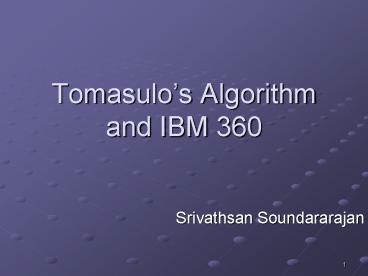Tomasulo PowerPoint PPT Presentation
Title: Tomasulo
1
Tomasulos Algorithm and IBM 360
- Srivathsan Soundararajan
2
What we have seen till now!!!
- Single-cycle datapath.
- Multi-cycle datapath.
- N-stage Pipelined datapath.
3
Tomasulo's algorithm
- A hardware algorithm for controlling the
execution of multiple functional units with
varying latencies in a pipelined CPU
micro-architecture. - A general mechanism for register forwarding and
hazard detection. - The key idea is to virtually execute each
instruction in a single cycle. - Out-of-order execution of instructions.
4
So what is so special???
- Let instructions behind stall proceed.
- Decode instructions and check for structural
hazard. - Wait until no data hazard and then read operands.
5
Three Stages
- Issue if reservation station free (i.e. no
structural hazard), control issues instruction
and sends operands (renames registers). - Execution if both operands ready, then execute.
If not, watch common data bus for result. - Write result if CDB available, write on common
data bus to all awaiting units mark reservation
status available
6
Virtual result a promissory note
- All registers are modified so that they can
either hold a true result or a virtual result. - When an instruction is issued, a virtual result
is placed in the instruction's destination
register. - A functional unit is assigned to compute the real
result. - The virtual result is replaced by the real result
when the functional unit has completed its
computation.
7
Tomasulo Organization
8
The concept
- Each instruction, as it arrives, fetches its
operands from a special register file. - Each register in this file holds either an actual
value, or a tag indicating the reservation
station that will produce the register value when
it completes. - The instruction and its operands (either values
or tags) are stored in a reservation station
(RS). - The RS watches the results returning from the
execution pipelines, and when a result's tag
matches one of its operands, it records the value
in place of the tag
9
A good example
- http//www.cs.umd.edu/users/saltz/cmsc411-s97/toma
sulo.htm
10
Why Tomasulos Algorithm
- Hazard detection.
- Dynamic Scheduling (i.e. Hardware reorganizes
instructions)
11
IBM 360
- The IBM 360 introduced many new concepts,
including dynamic detection of memory hazards,
generalized forwarding, and reservation stations. - The approach is normally named Tomasulos
algorithm
12
Installation of the IBM 360/91 in the Columbia
Computer Center machine room in February or March
1969
Photo AIS archive.
13
IBM 360
- Was introduced by the team led by Michael Flynn
in 1966. - The internal organization of the 360/91 shares
many features with the Pentium III and Pentium 4,
as well as several other microprocessors. - One major difference was that there was no branch
prediction in the 360/91 and hence no
speculation. - Another major difference was that there was no
commit unit, so once the instructions finished
execution, they updated the registers.
Out-of-order instruction commit led to imprecise
interrupts, which proved to be unpopular and led
to the commit units in dynamically scheduled
pipelined processors since that time.
14
IBM 360
- Although the 360/91 was not a success, the key
ideas were resurrected later and exist in some
form in the majority of microprocessors like
Pentium II, Power PC 604 etc... - It ran under Operating System/360 -- a powerful
programming package of approximately 1.5 million
instructions that enabled the system to operate
with virtually no manual intervention.
15
IBM 360
- Within the central processing unit (CPU), there
were five highly autonomous execution units which
allowed the machine to overlap operations and
process many instructions simultaneously. - The five units were processor storage, storage
bus control, instruction processor, fixed-point
processor and floating-point processor. Not only
could these units operate concurrently, they
could also perform several functions at the same
time.
16
Some uses
- The IBM-360 family of computers ranged from the
model 20 minicomputer (which typically had 24 KB
of memory) to the model 91 supercomputer which
was built for the North American missile defense
system.
17
Quite huge isnt it???
18
References
- http//www.d.umn.edu/gshute/cs2521/arch/tomasulo.
html - http//euler.ecs.umass.edu/arch/parts/Part6-tomasu
lo.pdf - http//www.cs.indiana.edu/classes/p415-sjoh/readin
gs/smv/CadenceSMV-docs/smv/tutorial/node36.htmlto
masulo1 - http//www.beagle-ears.com/lars/engineer/comphist/
ibm360.htm - http//www.eecs.ucf.edu/lboloni/Teaching/EEL5708_
2006/slides/Tomasulo.ppt268,9,Three Stages of
Tomasulo Algorithm - http//www.cs.unc.edu/montek/teaching/fall-03/lec
tures/lecture-11.ppt723,4,Tomasulo Organization - http//www.ece.cmu.edu/jhoe/distribution/2005/741
/proj3.pdf - http//www.columbia.edu/acis/history/36091.html

